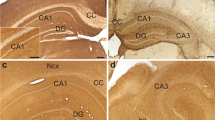Abstract
Neurotrophins regulate the proliferation and differentiation of neurons in the central nervous system via a family of specialized receptors, including TrkA, TrkB, and TrkC. As little is known about their expression or potential role in human glial tissues and glial tumors, we undertook an immunohistochemical analysis of human glia, glioma tissues and cell cultures of glial tumors to characterize the expression of Trk family members (full-length TrkA, TrkB, the truncated form of TrkB, and TrkC). In normal human brain Trk A, B, and C immunoreactivity was found in neurons and some weak staining was also seen astrocytes. No Trk expression was seen on oligodendrocytes. Strong reactivity was seen in reactive astrocytes in a glial scar. In a total of 34 glioma tissue specimens, which included 16 astrocytic tumors (4 low-grade astrocytomas and 12 glioblastomas multiforme) and 15 oligodendrogliomas (8 low-grade and 7 anaplastic) as well as 3 oligoastrocytomas (WHO grade II), TrkA, B, and C immunoreactivity was observed exclusively in specimens from astrocytic gliomas (16/16), but not in any of the oligodendrocytic gliomas (0/15). In the oligoastrocytomas, staining was restricted to the astrocytic component. In the astrocytoma and oligodendroglioma specimens, Trk A, B, and C immunoreactivity was also seen in the surrounding reactive astrocytes. Trk expression was independent of age, sex or histological grade of the investigated tumors. In six primary cell cultures, one derived from human astrocytes and five established from malignant astrocytomas, only TrkA immunoreactivity could be detected, while TrkB (both full-length and truncated isoforms) and TrkC were absent. The TrkA expression in primary cell cultures decreased with continuous cell passaging, and no Trk could be detected in established cell lines derived from glioblastoma. In conclusion, our data suggest that in human glial tissues Trk A, B, and C may be expressed in a lineage-restricted manner, thereby distinguishing between astrocytes and oligodendrocytes in a marker-like fashion. Trk expression, like GFAP expression appears to be increased in activated (reactive)/ neoplastic astrocytes.
Similar content being viewed by others
Author information
Authors and Affiliations
Additional information
Received: 15 January 1998 / Revised, accepted: 27 March 1998
Rights and permissions
About this article
Cite this article
Wang, Y., Hagel, C., Hamel, W. et al. Trk A, B, and C are commonly expressed in human astrocytes and astrocytic gliomas but not by human oligodendrocytes and oligodendroglioma. Acta Neuropathol 96, 357–364 (1998). https://doi.org/10.1007/s004010050906
Issue Date:
DOI: https://doi.org/10.1007/s004010050906




